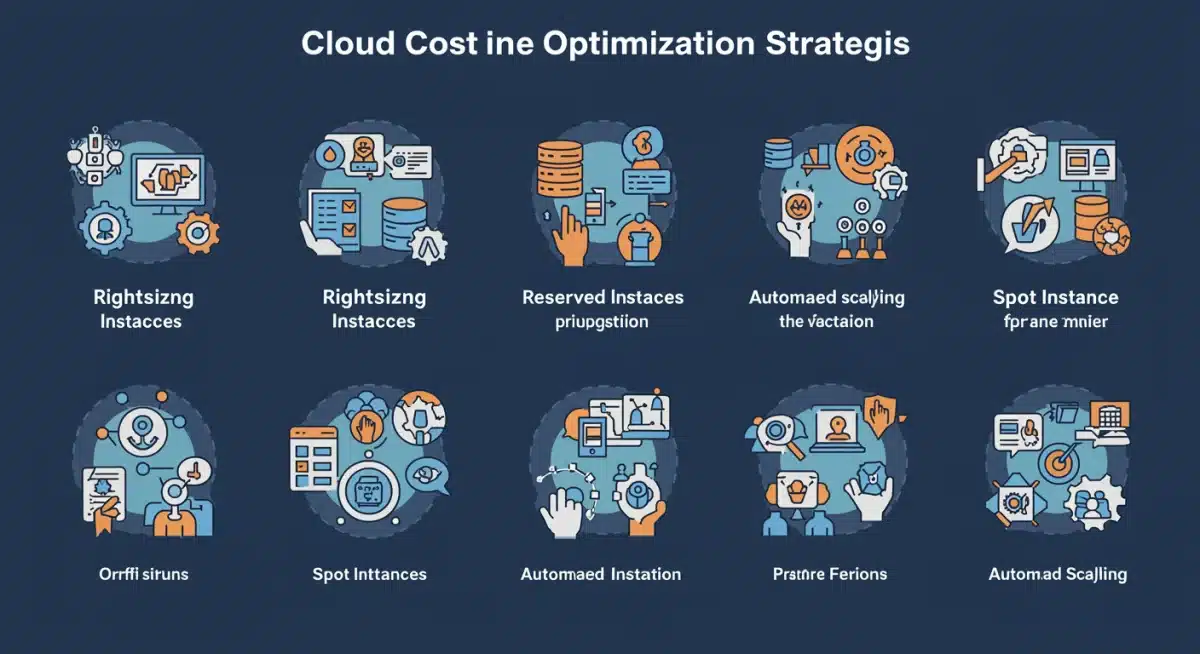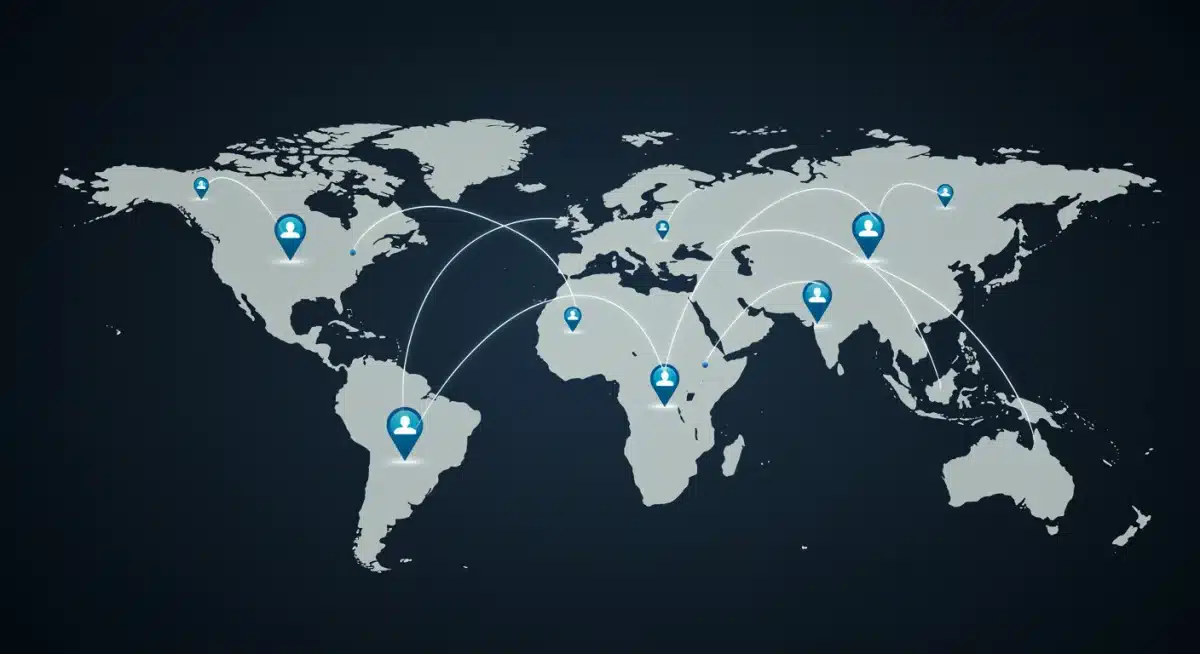Cloud Optimization for U.S. Companies: Global Access & 10% Cost Savings by 2025

U.S. companies are strategically implementing actionable insights to optimize their cloud infrastructure, targeting global access and a significant 10% cost reduction by early 2025 through enhanced efficiency and strategic resource management.
Actionable Insights: How U.S. Companies Can Optimize Their Cloud Infrastructure for Global Access and Save 10% on Costs by Early 2025 is rapidly becoming a critical directive for businesses navigating the competitive global landscape. This strategic imperative focuses on leveraging cloud technologies not just for operational efficiency, but as a cornerstone for international expansion and significant financial savings. As of today, industry leaders and analysts are detailing precise methodologies and anticipated impacts, underscoring a proactive shift in how American enterprises approach their digital foundations.
The Mandate for Cloud Optimization in a Global Economy
The drive for cloud optimization among U.S. companies is no longer merely about technological adoption; it is a strategic business necessity. With global markets becoming increasingly interconnected, the ability to deliver services and data efficiently across borders directly impacts competitiveness and customer satisfaction. The goal of a 10% cost saving by early 2025 serves as a tangible metric for success, pushing organizations to scrutinize every aspect of their cloud expenditure.
This push is fueled by several factors, including the surging demand for low-latency global services, the need for robust disaster recovery solutions, and the ever-present pressure to reduce operational overheads. Companies are realizing that a poorly optimized cloud infrastructure can negate the very benefits it promises, leading to spiraling costs and performance bottlenecks that hinder global reach.
Understanding the Cloud Cost Landscape
Many U.S. companies initially migrated to the cloud for agility and scalability, often without a clear long-term cost optimization strategy. This has led to scenarios where resources are over-provisioned, idle assets accumulate, and pricing models are not fully leveraged. The current mandate emphasizes a shift from reactive cost management to proactive, data-driven optimization.
- Rightsizing instances: Matching compute and storage resources to actual workload demands, eliminating over-provisioning.
- Reserved instances and savings plans: Committing to specific usage levels for significant discounts compared to on-demand pricing.
- Spot instances: Utilizing unused cloud capacity for fault-tolerant workloads at substantially reduced costs.
- Automated scaling: Dynamically adjusting resources based on demand, preventing both over and under-provisioning.
By implementing these strategies, U.S. companies are not just cutting costs but also building a more resilient and adaptable infrastructure that can better serve a global user base. The focus is on intelligent resource allocation that supports both current demands and future expansion plans without unnecessary financial burden.
Strategic Approaches to Enhance Global Cloud Access
Achieving seamless global access requires more than just deploying applications in a single region. It demands a holistic strategy encompassing network architecture, data residency, and localized service delivery. U.S. companies are now prioritizing multi-region deployments and content delivery networks (CDNs) to reduce latency and improve user experience worldwide.
The complexity of international data regulations, such as GDPR and various regional compliance mandates, also necessitates careful planning. Companies must ensure their cloud infrastructure can meet these diverse requirements, often by strategically placing data closer to the end-users while maintaining centralized management and security protocols. This balance between global reach and local compliance is a critical component of successful cloud optimization.
Leveraging Multi-Region Deployments and CDNs
Deploying applications across multiple cloud regions brings data closer to users, significantly reducing network latency and improving application response times. This is particularly crucial for businesses with international customers or employees who rely on real-time data access. CDNs further enhance this by caching static content at edge locations worldwide, delivering it quickly to users regardless of their geographical location.
- Reduced latency: Faster load times and improved user experience for global audiences.
- Enhanced disaster recovery: Geographic redundancy ensures business continuity even if one region experiences an outage.
- Improved compliance: Ability to store data in specific regions to meet local regulatory requirements.
- Load balancing: Distributing traffic across multiple regions to prevent overload and maintain performance.
These architectural decisions are not just about performance; they are about building trust and reliability with a global customer base. U.S. companies understand that slow or unreliable services can quickly lead to customer churn, making these investments in global access critical for long-term growth.

Implementing FinOps for Sustainable Cost Reduction
FinOps, a portmanteau of Finance and Operations, is emerging as a crucial framework for managing cloud costs effectively. It promotes a culture of financial accountability and collaboration between finance, operations, and engineering teams. For U.S. companies aiming for a 10% cost saving by early 2025, FinOps provides the necessary governance and visibility to achieve and sustain these targets.
This approach moves beyond simple cost reporting to active cost management, forecasting, and optimization. It involves continuous monitoring of cloud spending, identifying waste, and making informed decisions about resource allocation. The integration of financial discipline with technical execution is what sets FinOps apart and makes it indispensable for significant cloud cost reduction.
Key Principles of FinOps Adoption
Adopting FinOps involves several key steps that U.S. companies are now prioritizing. These principles ensure that cloud spending aligns with business value, fostering a more efficient and cost-aware environment. It’s about empowering teams with data and responsibility, rather than just imposing budget cuts.
- Visibility: Comprehensive understanding of cloud spending across all departments and projects.
- Accountability: Assigning cost ownership to teams and individuals responsible for cloud resources.
- Optimization: Continuously identifying and implementing strategies to reduce waste and improve efficiency.
- Forecasting: Predicting future cloud expenditures based on historical data and projected growth.
- Collaboration: Fostering communication between finance, engineering, and business units to make informed decisions.
By embedding FinOps practices, U.S. companies can transform their cloud spending from a black box into a transparent and manageable asset. This framework is essential for not only achieving the 10% cost saving goal but also for maintaining financial health as cloud usage evolves.
The Role of Automation and AI in Cloud Optimization
Automation and artificial intelligence (AI) are pivotal in driving the next wave of cloud optimization for U.S. companies. Manual processes for managing cloud resources are often inefficient and prone to human error, making it difficult to achieve consistent cost savings and optimal performance. AI-driven tools can analyze vast amounts of data to identify patterns, predict usage, and recommend optimization strategies that would be impossible for human operators to uncover.
From automated scaling and load balancing to intelligent cost anomaly detection, these technologies are empowering companies to operate their cloud infrastructure with unprecedented efficiency. The integration of AI into cloud management platforms is becoming a standard practice, allowing U.S. businesses to maintain global access while simultaneously reducing operational expenses.
Automated Cloud Management Tools
Modern cloud environments are too complex for manual management alone. Automation tools provide the capability to respond dynamically to changing demands and optimize resources in real-time. This proactive management is crucial for both cost control and maintaining high performance for global users.
- Auto-scaling groups: Automatically adjust compute capacity to meet fluctuating demand, ensuring optimal performance and cost efficiency.
- Serverless computing: Reduces operational overhead by abstracting server management, allowing companies to pay only for actual execution time.
- AI-driven cost anomaly detection: Identifies unusual spending patterns and alerts administrators, preventing unexpected increases in bills.
- Automated resource tagging: Ensures all cloud resources are properly categorized for better cost allocation and management.
These automated solutions are not just about saving money; they are about freeing up valuable IT resources to focus on innovation rather than routine maintenance. For U.S. companies, this means accelerating development cycles and bringing new global services to market faster.
Data Residency and Compliance for Global Operations
Operating globally means navigating a complex web of data residency and compliance regulations. For U.S. companies, ensuring that their cloud infrastructure meets these diverse requirements is non-negotiable. Failure to comply can result in hefty fines, reputational damage, and loss of customer trust, making it a critical aspect of cloud optimization for global access.
Strategic placement of data centers, robust encryption protocols, and clear data governance policies are essential. Companies must understand where their data resides, who has access to it, and how it is processed to meet regional mandates such as GDPR in Europe, LGPD in Brazil, or specific data sovereignty laws in other nations. This requires a deep understanding of legal frameworks and collaboration with legal and compliance teams.

Ensuring Regulatory Adherence
Compliance is a continuous effort that requires ongoing monitoring and adaptation. U.S. companies are investing in tools and expertise to manage their compliance posture effectively across multiple jurisdictions. This proactive approach helps mitigate risks and ensures that global operations run smoothly.
- Geo-fencing data: Restricting data storage and processing to specific geographic locations.
- Data encryption: Implementing strong encryption at rest and in transit to protect sensitive information.
- Access controls: Granular permissions to ensure only authorized personnel can access data.
- Auditing and logging: Maintaining detailed records of all data access and processing activities for compliance audits.
By meticulously addressing data residency and compliance, U.S. companies can expand their global footprint with confidence, knowing that their cloud infrastructure is both optimized for performance and legally sound.
The Path to 10% Cost Savings by Early 2025
Achieving a 10% cost saving on cloud infrastructure by early 2025 is an ambitious yet attainable goal for U.S. companies. This target is driven by a combination of technological advancements, strategic planning, and a cultural shift towards financial accountability within IT departments. The focus is not just on cutting costs, but on optimizing spending to maximize business value and global reach.
Success hinges on a continuous cycle of assessment, optimization, and monitoring. Companies that embrace these principles are already seeing significant returns on their cloud investments, proving that strategic cloud management can indeed lead to substantial financial benefits while simultaneously enhancing global operational capabilities. The journey requires commitment, but the rewards are clear.
Key Milestones for Cost Reduction
The roadmap to 10% cost savings involves several critical milestones. These are not one-time actions but ongoing processes that require dedicated effort and continuous improvement. U.S. companies are breaking down this goal into manageable steps to ensure consistent progress.
- Baseline assessment: Understanding current cloud spending and identifying areas of waste.
- Optimization plan: Developing a detailed strategy for rightsizing, reserved instances, and automation.
- Tool implementation: Deploying FinOps tools and AI-driven platforms for continuous monitoring and optimization.
- Team education: Training finance, engineering, and operations teams on cost management best practices.
- Regular review: Conducting periodic reviews of cloud spending and performance to identify new optimization opportunities.
By diligently following this path, U.S. companies can confidently move towards their 10% cost savings target, reinforcing their financial stability and sharpening their competitive edge in the global marketplace.
Key Optimization Area |
Brief Description |
|---|---|
Cost Management |
Implementing FinOps, rightsizing resources, and leveraging reserved instances to reduce cloud spend. |
Global Access |
Utilizing multi-region deployments and CDNs for low-latency, high-performance service delivery worldwide. |
Automation & AI |
Deploying automated scaling, serverless, and AI-driven tools for efficient resource management and anomaly detection. |
Compliance & Data Residency |
Ensuring adherence to international data regulations through geo-fencing, encryption, and robust governance. |
Frequently Asked Questions About Cloud Optimization
The primary goal is to optimize cloud infrastructure for enhanced global access and to achieve a significant 10% reduction in operational costs by early 2025. This involves strategic resource allocation and advanced management techniques.
FinOps establishes a culture of financial accountability and collaboration, integrating finance, operations, and engineering. It provides frameworks for continuous monitoring, forecasting, and optimizing cloud spending, turning cost management into a proactive strategy.
Multi-region deployments bring data and services closer to global users, drastically reducing latency and improving application performance. This strategy also enhances disaster recovery capabilities and aids in meeting diverse data residency requirements.
Automation and AI are vital for dynamic resource management, automated scaling, and intelligent cost anomaly detection. They enable real-time optimization, reduce manual effort, and ensure efficient resource utilization across complex cloud environments.
Key challenges include navigating diverse international data residency laws, maintaining robust encryption, implementing granular access controls, and conducting regular audits. Adherence to regulations like GDPR is crucial to avoid penalties and maintain trust.
What this means
The push for Cloud Optimization U.S. Companies to achieve global access and 10% cost savings by early 2025 signifies a mature phase in cloud adoption. It underscores a fundamental shift from reactive troubleshooting to proactive, strategic management of digital infrastructure. Companies that embrace these actionable insights, integrate FinOps, leverage automation, and prioritize global compliance will not only secure financial benefits but also fortify their competitive position in an increasingly interconnected world. The coming months will reveal which strategies yield the most impactful results, setting new benchmarks for efficiency and global reach in the digital age.





